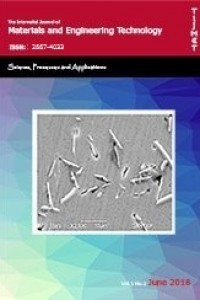A STUDY ON THE DESIGN AND PERFORMANCE ANALYSIS OF AN AIR-COOLED WASTE HEAT RECOVERY SYSTEM FOR USE IN MOTORCYCLE ENGINES
A STUDY ON THE DESIGN AND PERFORMANCE ANALYSIS OF AN AIR-COOLED WASTE HEAT RECOVERY SYSTEM FOR USE IN MOTORCYCLE ENGINES
Motorcycle engine, Internal combustion engine Thermoelectric generator Waste heat recovery system, Heat transfer,
___
- [1]. Dong H, Geng Y, Yu X, Li J. Uncovering energy saving and carbon reduction potential from recycling wastes: A case of Shanghai in China. Journal of Cleaner Production 2018; 205: 27-35.
- [2]. Khoo HH. LCA of plastic waste recovery into recycled materials, energy and fuels in Singapore. Elsevier Resources, Conservation & Recycling 2019;145: 67-77.
- [3]. Arias DA, Shedd TA, Jester RK. Theoretical analysis of waste heat recovery from combustion engine in a hybrid. SAE Transactions 2006; 115: 777-784.
- [4]. Yasa T. Thermodynamıc evaluatıon of energy recovery system for heavy duty dıesel engıne by usıng organıc rankıne cycle. Anadolu University Journal of Science and Technology A- Applied Sciences and Engineering 2017; 18: 573-583.
- [5]. Kunt MA. İçten yanmalı motor atık ısılarının geri kazanımında termoelektrik jeneratörlerin kullanımı. El-Cezerî Journal of Science and Engineering 2016; 3: 192-203.
- [6]. Stone R. Introduction to Internal Combustion Engines. 2th ed. London: The Macmıllan Press, 1992, pp. 1-16.
- [7]. Galindo J, Serrano JR, Dolz V, Kleut P. Brayton cycle for internal combustion engine exhaust gas waste heat recovery. Advances in Mechanical Engineering 2015; 7: 1-9.
- [8]. Lou D, Wang R, Yu W, Sun Z, Meng X. Modelling and simulation study of a converging thermoelectric generator for engine waste heat recovery. Elsevier Applid Thermal Engineering 2019; 153: 837-847.
- [9]. A. Massaguera, E. Massaguerb, M. Comamalaa, et al. Transient behavior under a normalized driving cycle of an automotive thermoelectric generator. Elsevier Applied Energy 2017; 206: 1282-1296.
- [10]. Wang T, Shaolei MA. Teg heat performance study about ımproved fın structures. Thermal Science International Scientific Journal 2018; 22: 101-112.
- [11]. Hsu CT, Huang GY, Chu HS, et al. Experiments and simulations on low-temperature waste heat harvesting system by thermoelectric power generators. Elsevier Applied Energy 2011; 88: 1291-1297.
- [12]. Temizer I, Yuksel T, Can I, et al. Analysis of an automotive thermoelectric generator on a gasoline engine. Thermal Science International Scientific Journal 2020; 24: 137-145.
- [13]. He W,Wang S, Lu C, et al. Influence of different cooling methods on thermoelectric performance of an engine exhaust gas waste heat recovery system. Elsevier Applied Energy 2016; 162: 1251-1258.
- [14]. Cho YH, Park J, Chang N, et al. Comparison of cooling methods for a thermoelectric generator with forced convection. Energies 2020; 13: 3185-3204.
- [15]. Kunt MA. An experimental investigation of exhaust waste heat recycling by thermoelectric generators under different thermal conditions for internal combustion engines. Proc IMechE Part D Journal of Automobile Engineering 2017; 232: 1648-1653.
- [16]. Khalil H, Hassan H. Enhancement thermoelectric generators output power from heat recovery of chimneys by using flaps. Elsevier Journal of Power Sources 3 October 2019. DOI:.org/10.1016/j.jpowsour.2019.2272 443: 227266.
- [17]. Lee H, Attar AM And Weera SL. Performance prediction of commercial thermoelectric cooler modules using the effective material properties. Journal of Electronıc Materıals 2015; 44: 2157- 2165.
- [18]. Attar A Lee H, And Weera SL. Experimental validation of the optimum design of an automotive air-to-air thermoelectric air conditioner (TEAC). Journal of Electronıc Mater 2015; 44: 2177-2185.
- [19]. Snyder GJ, Toberer EC. Complex thermoelectric materials. Nature Materials 2008; 7: 105-114.
- [20]. H. J. Goldsmid. Introduction to thermoelectricity. 1th ed. Berlin Heidelberg: Springer, 2010, p.23.
- [21]. Lee HS, Thermoelectrics design and materials. 1th ed. USA: John Wiley, 2016, p.61.
- [22]. Dhoopagunta S. Analytical modeling and numerical simulation of a thermoelectric generator ıncluding contact resistances. Master's Theses, Western Michigan University, USA, 2016.
- [23]. Li Z, Li W and Chen Z. Performance analysis of thermoelectric based automotivewaste heat recovery system with nanofluid coolant. Energies 2017; 10: 1489-1504.
- [24]. Nesarajah M, Frey G. Thermoelectric power generation: peltier element versus thermoelectric generator. In: Iecon 2016 - 42nd annual conference of the IEEE ındustrial electronics society, Florence, Italy, 23-26 Oct. 2016, 16557363. pp. 4252-4257.
- [25]. Incropera FP, DeWitt DP. Fundamentals of heat and mass transfer. 4th ed. USA: John Wıley & Sons, 2003, pp. 97-911.
- [26]. Orak IM, Celik A. A parallel algorithm for defect detection of rail and profile in the manufacturing. Journal of the Faculty of Engineering and Architecture of Gazi University 2017; 32: 439-448.
- [27]. Çam S. Tek emişli iki çıkışlı santrifüj pompanın tasarımı, had yöntemi ile optimizasyonu ve deneysel incelenmesi. Master’s Theses, Sakarya University, Turkey, 2019.
- [28]. Lin CX, Kiflemarian R. Numerical simulation and validation of thermoeletric generator based self-cooling system with airflow. Energies 2019; 12: 4052-4073.
- Yayın Aralığı: Yılda 2 Sayı
- Başlangıç: 2018
- Yayıncı: Necip Fazıl YILMAZ
INVESTIGATION OF THE HUB DIAMETER EFFECT ON PROPELLER THRUST
Enes COŞKUN, Mehmet Hanifi DOĞRU
ANALYSIS OF WIND TURBINE BLADE PITCH ANGLE CONTROL WITH FUZZY LOGIC
Mahmut Furkan KALKAN, Murat ARTAN, Hasan Mithat DELİBAŞ, Abdulcabbar YAVUZ, Necip Fazıl YILMAZ
Oğuzcan GÜZELİPEK, Tuğrul SOYUSİNMEZ, Furkan ÇETİN
EFFECT OF PROPELLERS NUMBERS AND HORIZONTAL DISTANCE IN DESIGN OF VTOL
Mustafa VARKİ, Eyüp YETER, Mehmet Hanifi DOĞRU
Doğan ACAR, Salim Levent AKTUĞ, Kemal KORKMAZ, Salih DURDU, Ömer Necati CORA
EFFECT OF DIFFERENT AMOUNTS OF CARBON FIBER ADDITIVE ABS ON THERMAL DISTORTION AND COOLING TIME
Ömer EYERCİOĞLU, Engin TEK, Mehmet ALADAĞ, Gülağa TAŞ
ANALYSIS OF MECHANICAL BEHAVIOR OF TERMOPLASTIC COMPOSITES
Ali Taner KUZU, Elifnur KÖSEMEN, Aysu Hande YÜCEL, Mustafa BAKKAL
